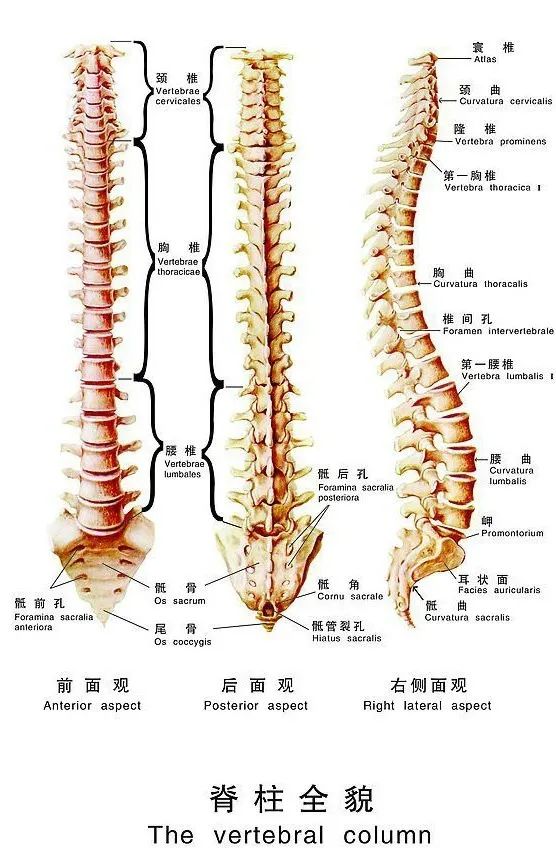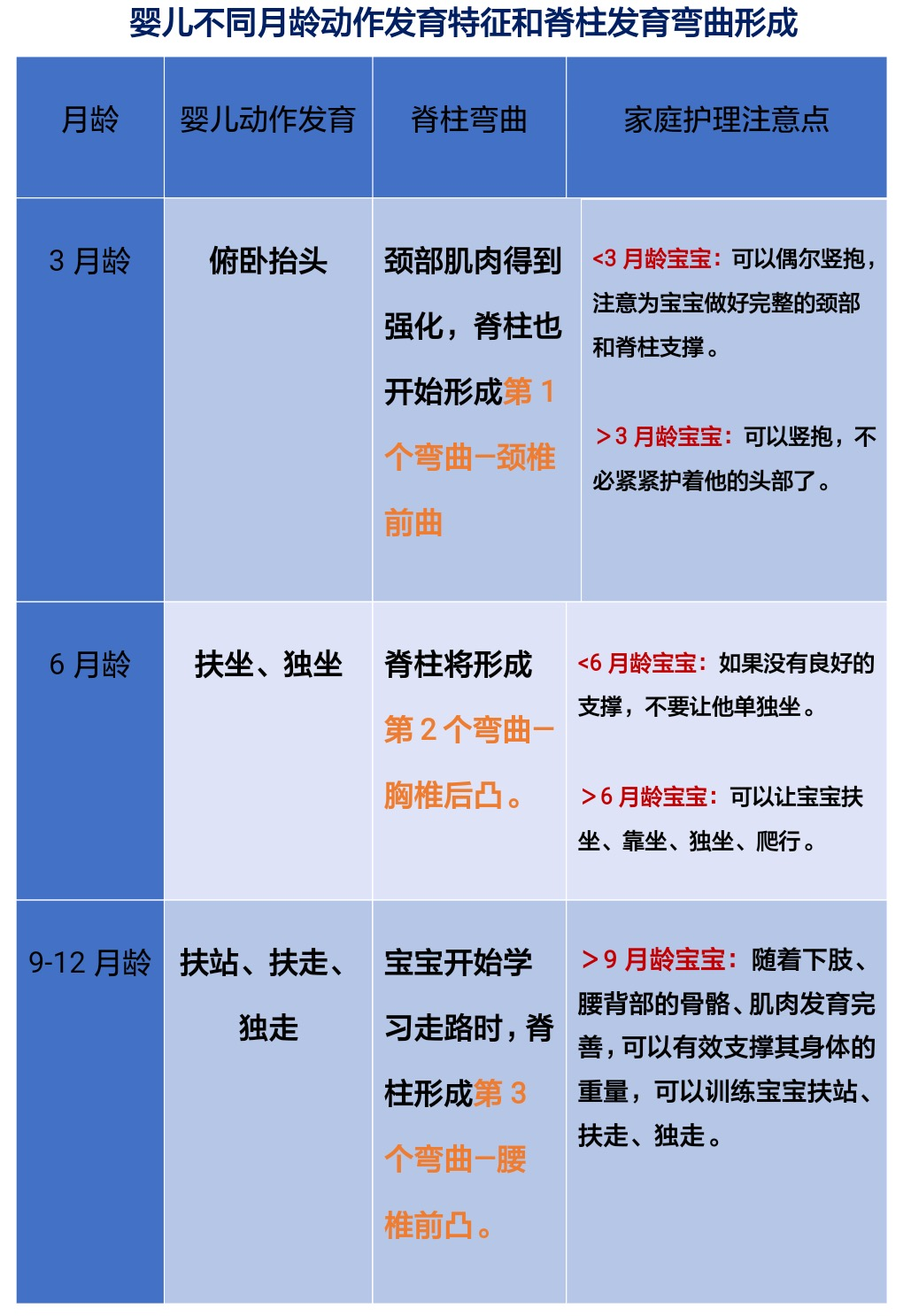Parents are very concerned about the growth of the baby, in addition to observing with the eyes, but also often feel with the hands, such as whether the baby is fat, whether the baby’s various abilities are developing normally.. But sometimes, lack of some medical knowledge can also make a joke.

The problem that often encounters in
outpatient service: “Doctor, how is the rachis of my home darling curved, sit to have bulge, be abnormal?” If you have such a question, you might as well learn it together.
Spine, straight or curved?

The spine, which bears the weight of a person’s whole body, is one of the cornerstones of normal human activities. For babies, the spine develops most rapidly before the age of 1. At the same time, spinal development is a very important link in the development of large movements in the growth and development stage of infants and young children, so it is very important for the healthy development of the baby’s spine. So, what is the normal shape of the spine?

Our human spine consists of 33 vertebrae and 23 intervertebral discs. The spine is divided into four main parts: cervical, thoracic, lumbar and sacral. Among them, there are 7 cervical vertebrae, 12 thoracic vertebrae, 5 lumbar vertebrae, 5 sacral vertebrae fused into sacrum, and 4 coccygeal vertebrae formed coccyx. Except for the first and second cervical vertebrae, all vertebrae have the same basic components, which are composed of vertebral body, pedicle, lamina and process. There are three types of process: intra-articular, transverse and spinous. Generally speaking, the protrusion of the spine that parents feel when the baby is sitting is the spinous process on the dorsal side of the spine.
Whether the
spine is straight or curved should be seen from two angles. Spinal curvature When viewed from the front (coronal plane), a healthy spine is straight. (The curvature of the spine to the side is called scoliosis). When viewed from the side (sagittal plane), the mature spine has four distinct curves. Of these, the thoracic and sacral curves are kyphotic and the cervical and lumbar curves are lordotic.
Spine, not born stereotyped

The physiological curvature of the side of the
spine has a developmental process, and the newborn baby’s spine has no curvature, only a slight kyphosis. Since then, with the growth of the baby’s age and the maturity of the movement development, various physiological bends have gradually emerged. These natural curves of the spine are usually not fixed by ligaments until the baby is 6 to 7 years old. Babies will form three natural bends before birth, as shown in the following table:

Pay attention to the daily protection
of the baby’s spine

The formation of physiological curvature of the
spine is related to the upright posture of human beings, which is a human characteristic and has the function of strengthening the elasticity of the spine. With the growth of the baby’s age and the development of big movements, the “S” curve on the side of the spine will eventually be formed, which is conducive to the occurrence and development of future movements, and the two complement each other. Since the spine is so important for the growth of the baby, parents must learn to avoid going astray and take good care of the spine.

Myth 1: The softer the bed, the better
.
The baby’s spine has not grown well, he is so tender and weak, the small bed to sleep can not be too hard, is the softer the better? The answer is wrong! Contribute to the baby’s spinal development of the small bed to be neither soft nor hard, moderate. Too hard bed is uncomfortable to sleep, too soft is not conducive to the development of the spine, but also brings the risk of suffocation.

Mistake 2: Fall asleep
with your baby in your arms
For crying, do not want to sleep baby, mom and dad always like to hold him to sleep, but also worried about putting down will wake him up, so even if the baby fell asleep also dare not let go, in fact, this habit is very bad: on the one hand, when holding sleep baby’s spine in a state of bending; On the other hand, this habit can cause sleep disorders in babies, and there is no sense of security without holding them. Natural sleep is conducive to the formation of cervical curvature and S-shaped scoliosis. It is not natural to sleep for a long time. As a result, the baby’s spine will bend in the direction of the parents’holding posture.

Mistake 3: You can’t sit in a safety
seat when you are young.
For some parents, because the baby can’t sit within 4 months, they will feel that the baby can’t sit in the safety seat at this time. In fact, there are corresponding safety seat products for different age groups, and even the newborn has one suitable for him. As long as you choose the right product for your age, when your baby sits in it, his spine is completely leaning on it, not sitting alone with his back hanging in the air, which will not affect the development of his spine. On the contrary, if the baby is held by parents and does not sit in a safety seat, there may be more potential safety hazards.

Myth 4: Climbing is better
than standing
Many parents may have heard the saying that children who can crawl are smarter! So by the age of 10 months, instead of encouraging babies to stand, they are more willing to crawl. But in fact, whether it’s worrying that the baby will stand up too early and cause bowlegs, or simply thinking that the baby will “become smarter” by practicing crawling more, these practices will delay the age of the baby to start walking independently. Generally speaking, 9 to 10-month-old babies can be trained to crawl and stand at the same time. As long as the physical examination results show that the baby’s hip joint development is normal and there is no obvious calcium deficiency, then the appropriate standing training at this age will not affect the bone development of the baby’s legs.

The Right Way
to
Hold Vertically Babies from
2 to 3 months old can be held vertically for a while, but not too long. When holding him vertically, Mom and Dad must hold his neck completely with their hands to prevent injury to the cervical spine. You can also try to hold the baby in reverse, so that the baby’s face is outward and the back is on the chest of the parents. Such posture, can let the baby’s head and neck get complete dependence, at this time you use one hand to support his buttocks, the other hand from the armpit around the baby, can broaden the baby’s vision, not only increase his sensory stimulation, but also do not damage the cervical spine at the same time, but also let the baby’s neck stand more safely.

Baby Spine Protection
Protect the spine from the moment the baby is born, conform to the natural growth law, do not pull out seedlings to promote growth, do not over-protect. In addition to some of the common problems mentioned above, parents should also pay attention to some disease factors, such as birth defects, spina bifida, vitamin D deficiency rickets, which can cause spinal deformity, scoliosis, trauma, inflammation and other diseases, which should be detected as early as possible.